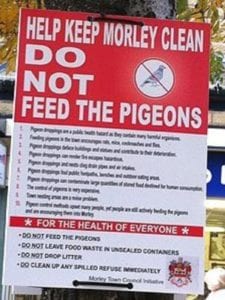
by Pigeon Patrol | Mar 4, 2020 | 4-S Gel Bird repellent, Animal Deterrent Products, Bird Deterrent Products, Bird Netting, Bird Spike, Bird Spikes, Pigeon Control, Pigeon Droppings, Pigeon Patrol's Services, Pigeon Spikes, Pigeons in the News, UltraSonic Bird Control
Town Council agrees pigeons cull
A cull of pigeons has been approved at a meeting of a West Yorkshire town council.
Bird droppings have caused £50,000 of damage to Morley Town Hall by blocking drains which have caused flooding.
People have been told not to feed the problem birds and now council officials say that they have to decide on the most effective method.
The Pigeon Control Advisory Service told the BBC that culling “causes the birds to rebreed”.
“We are not throwing away our rubbish properly and we’re feeding them over and above what they need,” said Emma Haskell, of the Pigeon Control Advisory Service.
“The key message is to stop feeding them.”
‘Ate alive’
Ms Haskell said that in the USA, contraceptives were fed to birds to control their population, but they were not used in the UK because contraceptives had not been proven to be an effective method of control.
Elsewhere in the UK, councils have used birds of prey to keep the pigeon population at bay, but Ms Haskell said this was not recommended either.
“The peregrine falcon is the pigeon’s natural predator, not the Harris hawk which is commonly used,” she said.
“Pigeons fly a lot faster than the Harris hawk and it will only ever catch young, injured or sick pigeons.
“There was outrage in Norwich when a Harris hawk flew down and ate alive a pigeon in the middle of the town centre. It was all very upsetting.”
Source
At Pigeon Patrol, we manufacture and offer a variety of bird deterrents, ranging from Ultra-flex Bird Spikes with UV protection, Bird Netting, 4-S Gel and the best Ultrasonic and audible sound devices on the market today.
Contact us at 1- 877– 4– NO-BIRD, (604) 585-9279 or visit our website at www.pigeonpatrol.ca
Bird Gone, Pigeon Gone, Seagull Gone, Pigeon issue, pigeon spikes, 1-877-4NO-BIRD, 4-S Gel, Bird Control, Pigeon Control, bird repellent, Bird Spikes, sonic bird repellent, stainless steel bird spikes, bird spikes Vancouver, Ultra Sonic Bird Control, Bird Netting, Plastic Bird Spikes, Canada bird spike deterrents, Pigeon Pests, B Gone Pigeon, Pigeon Patrol, pest controller, pest control operator, pest control technician, Pigeon Control Products, humane pigeon spikes, pigeon deterrents, pigeon traps, Pigeon repellents, Sound & Laser Deterrents, wildlife control, raccoon, skunk, squirrel deterrent, De-Fence Spikes, Dragons Den, Canada bird spikes, Canada pigeon, pigeon control, pigeon patrol, pigeon. Kill pigeons, crow, starling
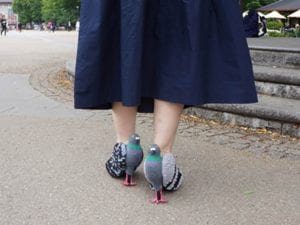
by Pigeon Patrol | Mar 4, 2020 | 4-S Gel Bird repellent, Animal Deterrent Products, Bird Deterrent Products, Bird Netting, Bird Spike, Bird Spikes, Pigeon Control, Pigeon Droppings, Pigeon Patrol's Services, Pigeon Spikes, Pigeons in the News, UltraSonic Bird Control
The in-toeing epidemic (pigeon toed gait) – estrogen?
The mystery of the in-toeing (pigeon toed) epidemic among young women continues:
http://charltonteaching.blogspot.com/2010/09/pigeon-toed-gait-endemic-among.html
(I am convinced that this gait is not an affectation – I am sure it is involuntary in most instances.)
The best suggested explanation came from Paul Jaminet – vitamin D deficiency; with its bone-softening effects.
This suggests that in-toeing may be a result of softening of the feet, in some way, shape or form; if not bones them perhaps joints?…
Which then leads on to the idea that it might be due to some increase in estrogen – whether natural, in contraceptives, or as an environmental pollutant (which may explain why surprising numbers of men walk this way too).
The only ‘evidence’ I can present for this is that estrogen softens and loosens joints (i.e. softening the ligaments that join bones to bones – this is well known in pregnancy) – perhaps making the ankles or internal joints of the foot more ‘floppy’, and hyper-flexible feet may cause the observed change in gait?
Well, I’m not very convinced by this – but the phenomenon is real and new, and there must be some explanation!
NOTE added – on further reflection I think the problem is likely to be neural – neuromuscular – rather than musculoskeletal – and subtly neuromuscular – hence perhaps related to basal ganglia dysfunction.
What ever causes basal ganglion dysfunction might be environmental toxins of some sort; but could also be infective – as many new diseases eventually turn-out to be.
Source
At Pigeon Patrol, we manufacture and offer a variety of bird deterrents, ranging from Ultra-flex Bird Spikes with UV protection, Bird Netting, 4-S Gel and the best Ultrasonic and audible sound devices on the market today.
Contact us at 1- 877– 4– NO-BIRD, (604) 585-9279 or visit our website at www.pigeonpatrol.ca
Bird Gone, Pigeon Gone, Seagull Gone, Pigeon issue, pigeon spikes, 1-877-4NO-BIRD, 4-S Gel, Bird Control, Pigeon Control, bird repellent, Bird Spikes, sonic bird repellent, stainless steel bird spikes, bird spikes Vancouver, Ultra Sonic Bird Control, Bird Netting, Plastic Bird Spikes, Canada bird spike deterrents, Pigeon Pests, B Gone Pigeon, Pigeon Patrol, pest controller, pest control operator, pest control technician, Pigeon Control Products, humane pigeon spikes, pigeon deterrents, pigeon traps, Pigeon repellents, Sound & Laser Deterrents, wildlife control, raccoon, skunk, squirrel deterrent, De-Fence Spikes, Dragons Den, Canada bird spikes, Canada pigeon, pigeon control, pigeon patrol, pigeon. Kill pigeons, crow, starling

by Pigeon Patrol | Mar 4, 2020 | 4-S Gel Bird repellent, Animal Deterrent Products, Bird Deterrent Products, Bird Netting, Bird Spike, Bird Spikes, Pigeon Control, Pigeon Droppings, Pigeon Patrol's Services, Pigeon Spikes, Pigeons in the News, UltraSonic Bird Control
Pigeon races up in the sky!
Pigeon racers from far afield have their eyes on Tasmania.
Avid pigeon racers are trying to establish a contest that rivals the great long distance, cross water, pigeon races held around the world.
Experienced fliers, George Rettas and Alex MacDonald and other enthusiasts organised the ‘Conquer the Strait’ one loft race from Perth in northern Tasmania.
The idea of the ‘Conquer the Strait’ challenge is to test some of Australia’s best racing pigeons over one of the roughest stretches of water in the world.
The race was designed for the birds to fly over more than 500 kilometres from south western Victoria, including over 300 kilometres of Bass Strait.
And while an outbreak of the paramixovirus in Victorian pigeons curtailed the inaugural race in October 2011, a shortened race format over 220 kilometres from Woolnorth to Perth was held.
Pigeon racers from far afield joined the Tasmanian long distance enthusiasts who were out to prove they have the best birds on earth.
Source
At Pigeon Patrol, we manufacture and offer a variety of bird deterrents, ranging from Ultra-flex Bird Spikes with UV protection, Bird Netting, 4-S Gel and the best Ultrasonic and audible sound devices on the market today.
Contact us at 1- 877– 4– NO-BIRD, (604) 585-9279 or visit our website at www.pigeonpatrol.ca
Bird Gone, Pigeon Gone, Seagull Gone, Pigeon issue, pigeon spikes, 1-877-4NO-BIRD, 4-S Gel, Bird Control, Pigeon Control, bird repellent, Bird Spikes, sonic bird repellent, stainless steel bird spikes, bird spikes Vancouver, Ultra Sonic Bird Control, Bird Netting, Plastic Bird Spikes, Canada bird spike deterrents, Pigeon Pests, B Gone Pigeon, Pigeon Patrol, pest controller, pest control operator, pest control technician, Pigeon Control Products, humane pigeon spikes, pigeon deterrents, pigeon traps, Pigeon repellents, Sound & Laser Deterrents, wildlife control, raccoon, skunk, squirrel deterrent, De-Fence Spikes, Dragons Den, Canada bird spikes, Canada pigeon, pigeon control, pigeon patrol, pigeon. Kill pigeons, crow, starling
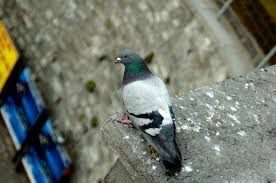
by Pigeon Patrol | Mar 4, 2020 | 4-S Gel Bird repellent, Animal Deterrent Products, Bird Deterrent Products, Bird Netting, Bird Spike, Bird Spikes, Pigeon Control, Pigeon Droppings, Pigeon Patrol's Services, Pigeon Spikes, Pigeons in the News, UltraSonic Bird Control
Pigeon fever is an equine disease that doesn’t have anything to do with pigeons. It’s an infection caused by the bacterium Corynebacterium pseudotuberculosis which results in the formation of abscesses, usually along the chest (pectoral region) and lowest part of the abdomen. The name “pigeon fever” comes from the swelling in the chest region that vaguely resembles a pigeon-breast. A recent report describes and outbreak of pigeon fever involving at least 30 horses in Louisiana, bringing the estimated number of cases in the state in 2011 to over 100.
Pigeon fever is a regionally (and to a lesser degree seasonally) variable disease. It predominantly occurs in California, but over recent years it has expanded its range in the western US, and from this report, it’s obvious that it has a good foothold in some other areas in the south east as well. 
Corynebacterium pseudotuberculosis lives in the soil, and causes infections in horses when it gets inoculated under the skin via wounds and perhaps sometimes through fly bites. Once it gets into the tissues, it starts to grow and causes painful (and potentially large) abscesses that often need to be surgically incised in order to drain them.
Infection control practices on farms can help reduce transmission of the bacterium between horses and to reduce the risk of injuries. These include:
- Quarantine of new arrivals and careful inspection for sign of infection.
- Isolation of known infected horses.
- Use of “contact precautions” when dealing with infected horses to prevent transmission of the bacterium via peoples’ bodies or clothing. This involves the use of protective outwear (e.g. coveralls and boots that are only used for the infected horse(s)) and gloves.
- Proper use of handwashing / hand sanitizer by people handling infected horses (or any horses, really, from a broader standpoint).
- Prevention of cross-use of items like buckets between infected/quarantined horses and the general horse population.
- Use of fly repellent, especially on horses with open wounds or draining abscesses.
- Careful cleaning and disinfection of areas potentially contaminated by pus from draining abscesses.
- Inspection of stalls, paddocks and fields for things that could cause wounds that might subsequently become infected.
Pigeon fever is a good example of why it’s important to know disease patterns in your region (and those to where your horses travel). Being aware of the possibility of a specific disease is an important step in diagnosis, and knowing there is disease activity in any area in which your horse may have been is a key part of that. This disease is also an example of why we need ongoing disease surveillance and reporting, because if a disease makes it into new regions, veterinarians and horse owners need to know about that as soon as possible to allow for quicker diagnosis and use of control measures. Unfortunately, organized disease surveillance and communication is sorely lacking in horses.
Source
At Pigeon Patrol, we manufacture and offer a variety of bird deterrents, ranging from Ultra-flex Bird Spikes with UV protection, Bird Netting, 4-S Gel and the best Ultrasonic and audible sound devices on the market today.
Contact us at 1- 877– 4– NO-BIRD, (604) 585-9279 or visit our website at www.pigeonpatrol.ca
Bird Gone, Pigeon Gone, Seagull Gone, Pigeon issue, pigeon spikes, 1-877-4NO-BIRD, 4-S Gel, Bird Control, Pigeon Control, bird repellent, Bird Spikes, sonic bird repellent, stainless steel bird spikes, bird spikes Vancouver, Ultra Sonic Bird Control, Bird Netting, Plastic Bird Spikes, Canada bird spike deterrents, Pigeon Pests, B Gone Pigeon, Pigeon Patrol, pest controller, pest control operator, pest control technician, Pigeon Control Products, humane pigeon spikes, pigeon deterrents, pigeon traps, Pigeon repellents, Sound & Laser Deterrents, wildlife control, raccoon, skunk, squirrel deterrent, De-Fence Spikes, Dragons Den, Canada bird spikes, Canada pigeon, pigeon control, pigeon patrol, pigeon. Kill pigeons, crow, starling
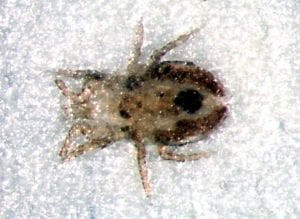
by Pigeon Patrol | Feb 26, 2020 | 4-S Gel Bird repellent, Animal Deterrent Products, Bird Deterrent Products, Bird Netting, Bird Spike, Bird Spikes, Pigeon Control, Pigeon Droppings, Pigeon Patrol's Services, Pigeon Spikes, Pigeons in the News, UltraSonic Bird Control
Bird Mites Infesting Pigeons, Smaller Than Bed Bugs? Unfortunately, this is VERY possible….
As many of you know, New York City, has become the home to an astronomical number of Pigeons. Yes I am talking about the pigeons that rest and nest on your windowsills, balconies, fire escapes, and park benches everyday! Have you ever taken a step back to wonder why these birds seem to thrive in your neighborhood? I mean you do live in New York City, why would such a huge population of birds thrive in an overcrowded, polluted, concrete jungle?
Well.. the primary reason behind this infestation (that many people are comfortable with and encourage) is likely the absence of the Pigeon’s natural predators. I mean how often do you see a peregrine falcon swooping down to the curb of a New York City street? Large cities provide Pigeons with an abundance of food and shelter that is not only maintaining their lifespan but also making it easier for them to mate more often. For many years pest control companies have been responding to complaints about pigeons with the recommendation of avian poisons. Some of the avian poisons, however, are nonselective in nature, meaning that non-target species may unfortunately have to take their last breath after ingesting or feeding on a bird that has ingested these poisons. For this very reason, in August of 2000 the NYC Governor signed a bill banning the use of select avian poisons. In coordination with the ban on pigeon control through the use of various avian poisons, pigeons are breeding at an exorbitant rate; resulting in an ever-growing pigeon population wreaking havoc on uninformed city-dwellers.
Ok, So by now you’re probably wondering what all of this pigeon talk has to do with bugs right? Well, here goes.
You see, when it comes to the pigeon problem in NYC, most people are worried about the repulsive droppings they leave behind on your homes, cars, and sidewalks.. Oh yeah! Don’t forget your clothes and hair, on a bad day. Some people may even worry about more serious things such as health hazards and the spread of disease. BUT the one thing most people have not considered is the pests of our pests. That’s right! BIRD MITES… Similar to bed bugs, bird mites are a parasite, meaning that they feed on the blood of living organisms. Although the host that bird mites prefer is birds, they are also attracted to mammals such as humans… yes… you! These itty bitty creatures will often bite humans when their natural food source (birds) is absent. Similar to their darling host, bird mites reproduce at a rapid pace, multiplying into thousands without warning.
Lucky for you, I am here to inform the uninformed.
There are many different types of bird mites, canary lung mites, feather mites, grey mites, and a major menace called the red mite. Red mites are generally as small as 1mm in length and are white or clear in color. However when they feed they will usually turn a dark red or brown. Bird mites are often nocturnal and feed on their hosts at night. These nearly microscopic creatures, averaging between.7 and 1 mm in length, are frequently overlooked or mistaken for bed bugs (Reference: 2). Unless they are moving, it is exceptionally difficult to see bird mites. Symptoms of bird mites include pin-size bites, itching, small red bumps, and a crawling sensation on the skin (Reference: 1). One way to check your live-in bird cage is to place a sheet over the concerning area, if there are small specks or stains when you remove the sheet then you may have something to worry about.
Bird mites have five stages in their life cycle: egg, larvae, protonymph, deutonymph and adult. The larvae can be identified by having three pair of legs, while the nymphs and adults have four pair (Reference: 2).
Now that you have an idea what to look for, let’s back track a little bit. Remember the astronomical pigeon population that we spoke about just a little while ago? Well we all know that the millions of pigeons that are dwelling on your windowsills and underneath your air conditioners may be a pester you; but what you really need to consider is that those same pigeons may have little pests of their own. Allowing pigeons to nest near windows and air conditioners increases the likelihood of bringing bird mites into your home, turning their pest problem into your pest problem!
Some advice I would offer in helping keep your home and family bird mite free would be to close all openings and holes that are large enough for birds to enter attics and install hardware cloth on porches and exterior surroundings to prevent roosting. Outdoor birds, such as pigeons, should be discouraged from nesting in or near buildings. Lastly, I highly recommend that residents disrupt nest-building efforts near home entrances and windows.
So I am sure many of you are thinking, “well I can’t have birdmites” or “that’s fine I’ll just stay away from the pigeons from now on”. If it were that simple, I guess this article in its essence would be meaningless. Bird mite infestations are difficult to eradicate and often require the assistance of a knowledgeable and experienced pest control company.
Source
At Pigeon Patrol, we manufacture and offer a variety of bird deterrents, ranging from Ultra-flex Bird Spikes with UV protection, Bird Netting, 4-S Gel and the best Ultrasonic and audible sound devices on the market today.
Contact us at 1- 877– 4– NO-BIRD, (604) 585-9279 or visit our website at www.pigeonpatrol.ca
Bird Gone, Pigeon Gone, Seagull Gone, Pigeon issue, pigeon spikes, 1-877-4NO-BIRD, 4-S Gel, Bird Control, Pigeon Control, bird repellent, Bird Spikes, sonic bird repellent, stainless steel bird spikes, bird spikes Vancouver, Ultra Sonic Bird Control, Bird Netting, Plastic Bird Spikes, Canada bird spike deterrents, Pigeon Pests, B Gone Pigeon, Pigeon Patrol, pest controller, pest control operator, pest control technician, Pigeon Control Products, humane pigeon spikes, pigeon deterrents, pigeon traps, Pigeon repellents, Sound & Laser Deterrents, wildlife control, raccoon, skunk, squirrel deterrent, De-Fence Spikes, Dragons Den, Canada bird spikes, Canada pigeon, pigeon control, pigeon patrol, pigeon. Kill pigeons, crow, starling
by Pigeon Patrol | Feb 26, 2020 | 4-S Gel Bird repellent, Animal Deterrent Products, Bird Deterrent Products, Bird Netting, Bird Spike, Bird Spikes, Pigeon Control, Pigeon Droppings, Pigeon Patrol's Services, Pigeon Spikes, Pigeons in the News, UltraSonic Bird Control
Bird fever Symptoms
Most people with acute pulmonary histoplasmosis have no symptoms or only mild symptoms. The most common bird fever symptoms are:
- Chest pain
- Chills
- Cough
- Fever
Joint pain and stiffness
- Muscle aches and stiffness
- Rash (usually small sores on the lower legs)
- Shortness of breath
Acute pulmonary histoplasmosis can be a serious illness in the very young, elderly, and people with weakened immune systems, including those who:
Have HIV/AIDS
Have had bone marrow or solid organ transplants
Take medications to suppress their immune system
Symptoms in these persons may include:
Inflammation around the heart (called pericarditis)
Serious lung infections
Severe joint pain
Exams and Tests
To diagnose histoplasmosis, the doctor needs to find the fungus or signs of the fungus in the body, or evidence that your immune system is reacting to the fungus.
Tests to detect Bird Fever symptoms include:
Antibody tests for histoplasmosis
Biopsy of infection site
Bronchoscopy (usually only done if symptoms are severe or you have an abnormal immune system)
Complete blood count (CBC) with differential
Chest CT scan
Chest x-ray (might show a lung infection or pneumonia)
Sputum culture (this test often does not show the fungus, even if you are infected)
Urine test for Histoplasma capsulatum antigen
Treatment
Most cases of histoplasmosis clear up without specific treatment. Patients are advised to rest and take medication to control fever.
Your doctor may prescribe medication if you are sick for more than 4 weeks, have a weakened immune system, or are having breathing problems.
Outlook (Prognosis)
When histoplasmosis infection is severe or gets worse, the illness may last for one to six months. Even then, it is rarely fatal.
Acute pulmonary histoplasmosis can become chronic pulmonary histoplasmosis (which does not go away).
Histoplasmosis can spread from the lungs to other organs through the bloodstream. This type of spread is usually seen in infants, young children, and persons with a weakened immune system.
Possible Complications
Acute pulmonary histoplasmosis can get worse over time, or can become chronic pulmonary histoplasmosis (which doesn’t go away).
Histoplasmosis can spread to other organs through the bloodstream (dissemination). This is usually seen in infants, young children, and patients with a suppressed immune system.
When to Contact a Medical Professional
Call your health care provider if:
You have symptoms of histoplasmosis, especially if you have a weakened immune system or have been recently exposed to bird or bat droppings
You are being treated for histoplasmosis and develop new symptoms
Prevention
Avoid contact with bird or bat droppings if you are in an area where the spore is common, especially if you have a weakened immune system.
At Pigeon Patrol, we manufacture and offer a variety of bird deterrents, ranging from Ultra-flex Bird Spikes with UV protection, Bird Netting, 4-S Gel and the best Ultrasonic and audible sound devices on the market today.
Source
Contact us at 1- 877– 4– NO-BIRD, (604) 585-9279 or visit our website at www.pigeonpatrol.ca
Bird Gone, Pigeon Gone, Seagull Gone, Pigeon issue, pigeon spikes, 1-877-4NO-BIRD, 4-S Gel, Bird Control, Pigeon Control, bird repellent, Bird Spikes, sonic bird repellent, stainless steel bird spikes, bird spikes Vancouver, Ultra Sonic Bird Control, Bird Netting, Plastic Bird Spikes, Canada bird spike deterrents, Pigeon Pests, B Gone Pigeon, Pigeon Patrol, pest controller, pest control operator, pest control technician, Pigeon Control Products, humane pigeon spikes, pigeon deterrents, pigeon traps, Pigeon repellents, Sound & Laser Deterrents, wildlife control, raccoon, skunk, squirrel deterrent, De-Fence Spikes, Dragons Den, Canada bird spikes, Canada pigeon, pigeon control, pigeon patrol, pigeon. Kill pigeons, crow, starling
by Pigeon Patrol | Feb 26, 2020 | 4-S Gel Bird repellent, Animal Deterrent Products, Bird Deterrent Products, Bird Netting, Bird Spike, Bird Spikes, Pigeon Control, Pigeon Droppings, Pigeon Patrol's Services, Pigeon Spikes, Pigeons in the News, UltraSonic Bird Control
What is Bird Fever, Bird Flu, scientifically known as Histoplasmosis, an acute (primary) pulmonary disease
Acute pulmonary histoplasmosis is a respiratory infection that is caused by inhaling the spores of the fungus Histoplasma capsulatum, the fungus that causes histoplasmosis. The infection usually affects the lungs and symptoms can vary greatly. It can sometimes affect other parts of the body, including the eyes, liver, central nervous system, skin, or adrenal glands. For example, “ocular histoplasmosis syndrome” (also known as “presumed ocular histoplasmosis”) is a condition that results in impaired vision (affects the eyes). Having a weakened immune system increases your risk for getting this disease (e.g., the very young, very old, or those with medical conditions that lower the body’s resistance to infections).
This Histoplasma organism thrives in moderate temperatures and moist environments. It is found in the central and eastern United States, eastern Canada, Mexico, Central America, South America, Africa, and Southeast Asia. It is commonly found in the soil in river valleys. It gets into the soil mostly from droppings from chickens, pigeons, starlings, blackbirds, and bats. Birds are not infected with it because of their high body temperatures, but they do carry it on their feathers. Bats can be infected because they have a lower body temperature than birds and can excrete the organism in their droppings.
To multiply, Histoplasma capsulatum produces small spores called conidia. The conidia of Histoplasma capsulatum are only two millionths of a meter (microns, �m) in diameter. When these conidia are inhaled, they are small enough that they enter the lungs and start an infection. Many of these infections are easily overlooked because they either produce mild symptoms or none at all. However, histoplasmosis can be severe and produce an illness similar to tuberculosis.
You can get sick when you breathe in spores that the fungus produces. Every year, thousands of people worldwide are infected, but most do not become seriously sick. Most have no symptoms or have only a mild flu-like illness and recover without any treatment.
Acute pulmonary histoplasmosis may happen as an epidemic, with many people in one region becoming sick at the same time. People with weakened immune systems (see Symptoms section below) are more likely to:
- Get the disease, if exposed to the fungus spores
- Have the disease come back
- Have more symptoms, and more serious symptoms, than others who get the disease.
Risk factors include traveling to or living in the central or eastern United States near the Ohio and Mississippi river valleys, and being exposed to the droppings of birds and bats. This threat is greatest after an old building is torn down, or when exploring caves.
Question: “The town where I live is home to a legion of pigeons, and we have many tales of people getting sick with “bird fever.” I am a teacher, and I work in a very old school. I have seen two very large piles of pigeon droppings in the school’s attic. I am concerned because I work on the floor directly below the attic, the ceiling of my classroom has cracks in it. Also, the school has recently installed a new air conditioning system in the attic. Am I at risk for catching bird fever?”
Answer: The fungus, Histoplasma capsulatum, can be found in pigeon droppings. Infection by H. capsulatum can cause the disease Histoplasmosis. Three fourths of those who are infected with the fungus exhibit no symptoms or show symptoms of influenza (“flu”). One quarter of those who are infected with the fungus exhibit illness of varying severity, and among these the most common illness is a pneumonia of short duration.
Source
At Pigeon Patrol, we manufacture and offer a variety of bird deterrents, ranging from Ultra-flex Bird Spikes with UV protection, Bird Netting, 4-S Gel and the best Ultrasonic and audible sound devices on the market today.
Contact us at 1- 877– 4– NO-BIRD, (604) 585-9279 or visit our website at www.pigeonpatrol.ca
Bird Gone, Pigeon Gone, Seagull Gone, Pigeon issue, pigeon spikes, 1-877-4NO-BIRD, 4-S Gel, Bird Control, Pigeon Control, bird repellent, Bird Spikes, sonic bird repellent, stainless steel bird spikes, bird spikes Vancouver, Ultra Sonic Bird Control, Bird Netting, Plastic Bird Spikes, Canada bird spike deterrents, Pigeon Pests, B Gone Pigeon, Pigeon Patrol, pest controller, pest control operator, pest control technician, Pigeon Control Products, humane pigeon spikes, pigeon deterrents, pigeon traps, Pigeon repellents, Sound & Laser Deterrents, wildlife control, raccoon, skunk, squirrel deterrent, De-Fence Spikes, Dragons Den, Canada bird spikes, Canada pigeon, pigeon control, pigeon patrol, pigeon. Kill pigeons, crow, starling
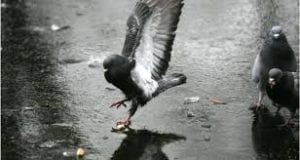
by Pigeon Patrol | Feb 26, 2020 | 4-S Gel Bird repellent, Animal Deterrent Products, Bird Deterrent Products, Bird Netting, Bird Spike, Bird Spikes, Pigeon Control, Pigeon Droppings, Pigeon Patrol's Services, Pigeon Spikes, Pigeons in the News, UltraSonic Bird Control
How Did the Pigeon Get to NYC? One can scarcely think of any park in NYC — or any city, really — without envisioning the ubiquitous pigeon there as well. Despite signs requesting you not feed the birds in adjacent Bryant Park, the library has more than its share of feathered patrons.
But how did this non-native species become the bird most associated with New York City? Pigeons are certainly not indigenous, but they have made themselves quite at home in the Big Apple. In Wild New York: A Guide to the Wildlife, Wild Places, & Natural Phenomena of New York City, authors Margaret Mittelbach and Michael Crewdson explain “Also called rock doves, pigeons were first brought to this country from Europe, probably during the 1600s, and that their original status here was that of a barnyard animal, raised purely for the table.”
Captive pigeons somehow struck out on their own, nesting easily in the crevices of buildings that are not that different than the cliff sides on which their ancestors dwelled. Over time, pigeons and their young squab dwindle from menus and dinner tables. Ironically, most city pigeons depend exclusively on humans to feed them, whether purposefully or accidentally through litter.
to feed them, whether purposefully or accidentally through litter.
Thousands of years ago in North Africa, people built dovecotes to house and raise pigeons for food and to use their droppings as fertilizers. New Yorkers have kept a similar relationship with pigeons by building coops on building rooftops and raising pigeons for racing and companionship. Bert on Sesame Street famously loves pigeons, enough to sing about it. Scientist Nikola Tesla was extremely fond of pigeons and would frequent NYC parks searching for injured birds, which he would then bring back to his residence at the Hotel New Yorker to nurse them back to health. His obsession with pigeons is documented in the novel The Invention of Everything Else and he had a favorite pigeon, which he mourned when she died.
The New York Times has covered pigeons in abundance and there are many non-fiction titles out there to help you learn more about these birds such as Pigeons: The Fascinating Saga of the World’s Most Revered and Reviled Bird by Andrew D. Blechman. There are pigeon appreciation groups and documentaries by local filmmakers, such as JL Aronson’s Up on the Roof. Pigeons are definitely part of New York’s wildlife and landscape.
Source
At Pigeon Patrol, we manufacture and offer a variety of bird deterrents, ranging from Ultra-flex Bird Spikes with UV protection, Bird Netting, 4-S Gel and the best Ultrasonic and audible sound devices on the market today.
Contact us at 1- 877– 4– NO-BIRD, (604) 585-9279 or visit our website at www.pigeonpatrol.ca
Bird Gone, Pigeon Gone, Seagull Gone, Pigeon issue, pigeon spikes, 1-877-4NO-BIRD, 4-S Gel, Bird Control, Pigeon Control, bird repellent, Bird Spikes, sonic bird repellent, stainless steel bird spikes, bird spikes Vancouver, Ultra Sonic Bird Control, Bird Netting, Plastic Bird Spikes, Canada bird spike deterrents, Pigeon Pests, B Gone Pigeon, Pigeon Patrol, pest controller, pest control operator, pest control technician, Pigeon Control Products, humane pigeon spikes, pigeon deterrents, pigeon traps, Pigeon repellents, Sound & Laser Deterrents, wildlife control, raccoon, skunk, squirrel deterrent, De-Fence Spikes, Dragons Den, Canada bird spikes, Canada pigeon, pigeon control, pigeon patrol, pigeon. Kill pigeons, crow, starling
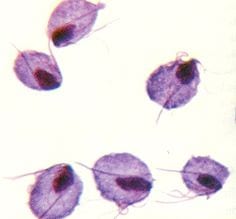
by Pigeon Patrol | Feb 26, 2020 | 4-S Gel Bird repellent, Animal Deterrent Products, Bird Deterrent Products, Bird Netting, Bird Spike, Bird Spikes, Pigeon Control, Pigeon Droppings, Pigeon Patrol's Services, Pigeon Spikes, Pigeons in the News, UltraSonic Bird Control
Trichomoniasis: Finding Sick, dying or dead pigeons?
Hello Everyone
We have been getting an increasing number of
Trichomoniasis related calls at this time of year. Every year outbreaks are seen during the late summer and autumn. This disease does not pose a threat to the health of humans, cats or dogs.

Greenfinches are reported most frequently, but potentially any bird can be infected, including pigeons and doves and some birds of prey. The trichomonad parasite lives in the upper digestive tract of the bird, and its actions progressively block the bird’s throat making it unable to swallow food, thus killing it by starvation.
The infection is spread as pigeons feed one another with regurgitated food during the breeding season, and through food and drinking water contaminated with regurgitated saliva. Saliva can also contaminate a birdbath. Trichomoniasis cannot live long outside a hosted pigeons.
Trichomoniasis causes lesions in the throat of the infected pigeons, which makes it progressively harder for the bird to swallow its food, and eventually breathe. Birds will also show signs of lethargy and fluffed up plumage, drooling saliva and regurgitated food. Affected birds frequently have matted wet plumage around the face and beak and uneaten food in and around the beak.
If a number of birds show symptoms, we recommend to stop putting out all food and leave bird baths dry for at least three weeks. This helps to disperse the feeding birds and reduce the contact between sick and healthy individuals, thus slowing down the outbreak. The higher the concentration of birds at a feeding station, the greater the chance of another bird picking up an infected food particle and exposing itself to the infection.
There are also a few other actions you can take to help:
Use feeders with drainage holes to avoid moisture building up
– Use more than one feeding site to reduce the number of birds in one place
– Rotate feeders around several locations to ‘rest’ each spot to prevent build up of infection on the ground underneath.
– Clean and disinfect feeders and water baths regularly, rinsing thoroughly and allowing to air dry completely – this itself will kill some diseases
– Keep the bucket and brush you clean feeders with outside and using just for this purpose
– Sweep up droppings and spilt or old food and disposing of it carefully in an outside bin
– Change the water in baths frequently – ideally daily
– Wash your hands carefully afterwards
No effective treatment can be administered to birds in the wild, because it is impossible to ensure that the infected individuals receive an adequate dose and that healthy birds do not pick up the medicine.
At Pigeon Patrol, we manufacture and offer a variety of bird deterrents, ranging from Ultra-flex Bird Spikes with UV protection, Bird Netting, 4-S Gel and the best Ultrasonic and audible sound devices on the market today.
Contact us at 1- 877– 4– NO-BIRD, (604) 585-9279 or visit our website at www.pigeonpatrol.ca
Bird Gone, Pigeon Gone, Seagull Gone, Pigeon issue, pigeon spikes, 1-877-4NO-BIRD, 4-S Gel, Bird Control, Pigeon Control, bird repellent, Bird Spikes, sonic bird repellent, stainless steel bird spikes, bird spikes Vancouver, Ultra Sonic Bird Control, Bird Netting, Plastic Bird Spikes, Canada bird spike deterrents, Pigeon Pests, B Gone Pigeon, Pigeon Patrol, pest controller, pest control operator, pest control technician, Pigeon Control Products, humane pigeon spikes, pigeon deterrents, pigeon traps, Pigeon repellents, Sound & Laser Deterrents, wildlife control, raccoon, skunk, squirrel deterrent, De-Fence Spikes, Dragons Den, Canada bird spikes, Canada pigeon, pigeon control, pigeon patrol, pigeon. Kill pigeons, crow, starling
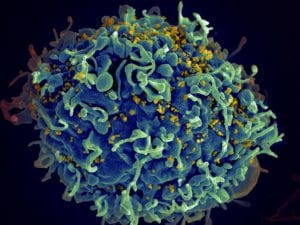
by Pigeon Patrol | Feb 26, 2020 | 4-S Gel Bird repellent, Animal Deterrent Products, Bird Deterrent Products, Bird Netting, Bird Spike, Bird Spikes, Pigeon Control, Pigeon Droppings, Pigeon Patrol's Services, Pigeon Spikes, Pigeons in the News, UltraSonic Bird Control
Did The Common Pigeon Bring An AIDS-Defining Fungus To Asia?
New research has shed light on the origins of a fungal infection which is one of the major causes of death from AIDS-related illnesses that pigeon may bring.
AsianScientist (May 4, 2011) – New research has shed light on the origins of a fungal infection which is one of the major causes of death from AIDS-related illnesses. The study, published yesterday in the journal PLoS Pathogens, shows how the more virulent forms of Cryptococcus neoformans evolved and spread out of Africa and into Asia. C. neoformans is a highly pathogenic fungi which causes life-threatening infections in immunocompromised humans.
The fungus mainly lives in decaying pigeon or chicken droppings and enters the human host through the respiratory tract. The spores spread to extrapulmonary tissues and the central nervous system where it causes meningitis. A particularly virulent form, C. neoformans variety grubii (Cng), is a major cause of death among HIV-AIDS infected patients.
Up to 1 million cases of cryptococcal meningitis that result in over 600,000 deaths are reported each year. Cryptococcal meningitis affects nearly 20 percent of HIV-AIDS patients in Thailand, where HIV-AIDS is an emerging epidemic.
Researchers from the U.K., Netherlands, and Naresuan University in Thailand took 183 clinical samples in Thailand and compared them with the global database of 77 isolates. Genetic sequencing revealed that the Thailand samples taken from 11 provinces were highly homogenous. In comparison with the rest of the world’s population of Cng, specifically Africa where most of the lineages are found, the strains in Thailand had significantly less genetic diversity.
Analyses on the origin of Thailand’s strain dated it back to an ancestral African population diverging within the last 7,000 years. The common pigeon, domesticated 5,000 years ago, is thought to have spread the pathogen through its excrements when it was introduced to Europe. Subsequent voyages from Europe to Asia 500 years ago may have allowed Cng to broaden its ecological range.
The article can be found at: Simwami SP et al. (2011) Low Diversity Cryptococcus neoformans Variety grubii Multilocus Sequence Types from Thailand Are Consistent with an Ancestral African Origin. ——
Source: Biotechnology and Biological Sciences Research Council.
At Pigeon Patrol, we manufacture and offer a variety of bird deterrents, ranging from Ultra-flex Bird Spikes with UV protection, Bird Netting, 4-S Gel and the best Ultrasonic and audible sound devices on the market today.
Contact us at 1- 877– 4– NO-BIRD, (604) 585-9279 or visit our website at www.pigeonpatrol.ca
Bird Gone, Pigeon Gone, Seagull Gone, Pigeon issue, pigeon spikes, 1-877-4NO-BIRD, 4-S Gel, Bird Control, Pigeon Control, bird repellent, Bird Spikes, sonic bird repellent, stainless steel bird spikes, bird spikes Vancouver, Ultra Sonic Bird Control, Bird Netting, Plastic Bird Spikes, Canada bird spike deterrents, Pigeon Pests, B Gone Pigeon, Pigeon Patrol, pest controller, pest control operator, pest control technician, Pigeon Control Products, humane pigeon spikes, pigeon deterrents, pigeon traps, Pigeon repellents, Sound & Laser Deterrents, wildlife control, raccoon, skunk, squirrel deterrent, De-Fence Spikes, Dragons Den, Canada bird spikes, Canada pigeon, pigeon control, pigeon patrol, pigeon. Kill pigeons, crow, starling
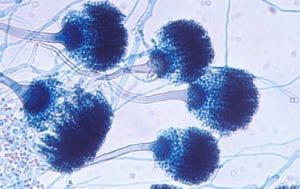
by Pigeon Patrol | Feb 26, 2020 | 4-S Gel Bird repellent, Animal Deterrent Products, Bird Deterrent Products, Bird Netting, Bird Spike, Bird Spikes, Pigeon Control, Pigeon Droppings, Pigeon Patrol's Services, Pigeon Spikes, Pigeons in the News, UltraSonic Bird Control
A new virus has been isolated from the tissues of pigeons with visceral lesions that were characterized by focal necrosis of parenchymatous tissue, by the presence in affected cells of

intranuclear inclusions of the herpetic type, and by secondary inflammatory reaction. This newly recognized virus, which has been tentatively called the I.N.I. agent is pathogenic for pigeons and embryonated eggs but is avirulent for rabbits, guinea pigs, and mice. The virus is smaller than the agent of psittacosis and is immunologically different from it. The I.N.I. agent and psittacosis virus were both of etiological importance in an epizootic among pigeons. Some birds were infected simultaneously with the two agents while others were infected with only one.
Source
At Pigeon Patrol, we manufacture and offer a variety of bird deterrents, ranging from Ultra-flex Bird Spikes with UV protection, Bird Netting, 4-S Gel and the best Ultrasonic and audible sound devices on the market today.
Contact us at 1- 877– 4– NO-BIRD, (604) 585-9279 or visit our website at www.pigeonpatrol.ca
Bird Gone, Pigeon Gone, Seagull Gone, Pigeon issue, pigeon spikes, 1-877-4NO-BIRD, 4-S Gel, Bird Control, Pigeon Control, bird repellent, Bird Spikes, sonic bird repellent, stainless steel bird spikes, bird spikes Vancouver, Ultra Sonic Bird Control, Bird Netting, Plastic Bird Spikes, Canada bird spike deterrents, Pigeon Pests, B Gone Pigeon, Pigeon Patrol, pest controller, pest control operator, pest control technician, Pigeon Control Products, humane pigeon spikes, pigeon deterrents, pigeon traps, Pigeon repellents, Sound & Laser Deterrents, wildlife control, raccoon, skunk, squirrel deterrent, De-Fence Spikes, Dragons Den, Canada bird spikes, Canada pigeon, pigeon control, pigeon patrol, pigeon. Kill pigeons, crow, starling
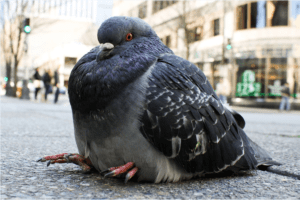
by Pigeon Patrol | Feb 26, 2020 | Animal Deterrent Products, Bird Deterrent Products, Bird Netting, Pigeon Control, Pigeon Droppings, Pigeon Patrol's Services, Pigeon Spikes, Pigeons in the News, UltraSonic Bird Control
I saw a fat pigeon the other day. There it was, doddering about on a Bowery doorstep, looking all smug and content. The fat pigeon had a fat pigeon ass and a fat pigeon belly that spanned the width of two normal birds, and I tried to imagine how the fat pigeon got to be so big. I pictured the fat pigeon tearing into a Big Mac, tufts of all-beef patty and sesame bun flying into the air with every peck, until the fat pigeon’s face was smeared with special sauce. I imagined the fat pigeon annihilating a holster of spilled French fries, and to be honest the thought of it got me pissed. Fries are for people, not pigeons. I stared at the fat pigeon long and hard, and the fat pigeon stared at me.
I’m not the only one who’s been seeing fat pigeons. In 2007, fat pigeons swarmed into Liverpool, England, pecking and pooping and plodding about, and so upset the locals that the City Council brought in 10 robotic peregrine falcons to scare off the zaftig varmints. A high-fat, garbage-based junk food diet had given the pigeons “a scruffy, unhealthy appearance,” explained one city official. Everyone agreed the fat pigeons had to go.
Of course, fat pigeons may be only the beginning. If one embarks on a tour of animal corpulence, spiraling out from captivity to the wild, a seemingly growing army of rotund beasts rounds into view. At home the fat animals are well known: They are fat husbands and fat children, fat dogs, fat cats, and fat pet macaws. Zoos and aquariums keep their own set of fat creatures in captivity. In 2008, for example, the dolphins at Japan’s Kinosaki Marine World grew too plump to jump, and were placed on a reduced-mackerel diet. A similar difficulty arose in a Shanghai aquarium when the sharks got so tubby that keepers gave them fish stuffed with cabbage to help them slim down.
Out in the country, some free-range fatties have sauntered onto the scene. Horse obesity is a growing concern on farms. In Arizona, wild burros have ballooned into genuine fat asses thanks to carrot-proffering tourists. The Lake Tahoe area’s garbage-eating black bears are unusually paunchy. And then there are the rats. Are the rats fat? One scientific study in 2010 found that feral rats collected near Baltimore had grown heavier over time. According to conventional wisdom, “wild” animals do not get fat. But is that truism breaking down for the commensal animals—like pizza-scarfing squirrels—that live in and around our fat- and sugar-laden “toxic” food environment? Has the obesity epidemic escaped from captivity? Is the Age of Fat Pigeons nigh?
Obesity researcher David Allison was on the team that identified the chunky urban rats. He and his colleagues also found signs of weight gain among captive populations of macaques, chimpanzees, vervets, marmosets, dogs, cats, and mice. For their study of vermin in the field, they reanalyzed weight data from rats captured in Baltimore alleyways as well as from rural rats trapped on parklands and farms between 1948 and 2006. The city rats had porked up more than the country rats, but both groups had probably needed to widen their burrows. I interviewed other rat experts who agreed that city rats tend to be huskier than their wild siblings, which subsist on bugs, slugs, acorns, and one another instead of half-eaten bagels and chicken wings. (Laboratory rats, with no room to exercise and all-you-can-eat feeding schedules, are bigger still.)
Allison says he doesn’t know why Baltimore’s rats have grown so large. (He doesn’t know for sure they have gotten fatter, as opposed to bigger overall, since his study only looked at weight.) It could be the result of the well-documented increase in food garbage, the selective killing of small rats by predators such as cats, changes in light exposure, improvements in rat health (perhaps facilitated by the food supply), or some environmental toxin that is disrupting the rats’ hormonal systems. Increasing temperatures might be another cause of rodent corpulence. A rat that spends less time shivering in the cold expends less energy. Scientists in Colorado report that shorter winters have given yellow-bellied marmots more time to forage and fill up their yellow bellies. (Climate change can work in the other direction, too: Sheep in the Scottish isles are thought to be getting smaller in the heat.) What about pigeons? Did Allison think the Age of Fat Pigeons was upon us? “[I]t would not at all surprise me if pigeons are more obese or fat than they used to be,” he said.
Different animals respond to calorie surpluses in different ways. Some species experience what biologists call “indeterminate growth” until late in their lives: As the animal takes in more food, it just gets bigger and bigger rather than storing excess calories as fat. Indeterminate growth is common among invertebrates such as earthworms and silverfish, but some mammals do it, too. A study from last year on crop-raiding African elephants showed that the well-nourished bulls got taller and longer and stronger and heavier than their pachyderm peers. All that extra food turned into pure tusker beefcake.
Humans, of course, stop growing in adulthood, so excess calories are converted to love handles under the right conditions. Baboons are the same way. Duke biologist Susan Alberts studied a group that lived near a tourist lodge in Kenya, and got most of its food by plundering a garbage dump instead of wandering the African plains. Not only did some of the animals get flabby as a result, she says, but they got dental cavities, too, and developed the sorts of insulin and cholesterol problems you’d see in a human case of metabolic syndrome. The scientists determined that the baboons weren’t getting sick from excess food—they took in the same number of calories as their wild-roaming brethren, despite a diet of discarded cake and pineapples—but rather they suffered from a lack of exercise. They did start having tons of healthy babies, though; increased fertility is the typical biological response to a surplus of food. The fat baboons are no longer being closely monitored, because the area where they hang out is patrolled by too many cantankerous wild buffaloes.
What did Alberts have to say about my fat pigeon? Did she think the global population of fat animals had reached an all-time high? She wasn’t sure. “If you went back to Egypt 5,000 years ago where they had lots of grain stored in granaries you can bet they had fat cats and fat mice and fat dogs.” But, she noted, “[W]herever there is excess human food, and humans have commensals, those commensals are going to be able to get fat.”
It might seem that birds shouldn’t get fat because they have to fly, but that is not the case. Many migratory birds get supremely blubbery in the days leading up to their big trip—some to 70 percent body fat. Adipose tissue weighs less than muscle, but it carries more energy, making it an essential resource for a long-distance flight. Pigeons don’t migrate, though, and despite their seasonal weight gain, birds tend not to be among the world’s top fatties. Research by the British zoologist Caroline Pond, author of The Fats of Life, suggests that human beings are among the bigger lard-asses in the animal kingdom, neck in neck with notable porkers like the hedgehog, the polar bear and the great whales, the fattest of God’s creatures. (The whole point of whaling was to get at their lipids.) In general carnivores tend to be more prone to growing chubby, as fatness is an adaptation to an unpredictable food supply.
Pond may be the world’s leading scholar of fat animals. Beginning in the early 1980s, she began riding her bike around the woodlands near her U.K. home at night collecting all the road kill she could carry: hedgehogs, badgers, foxes, whatever turned up stiff. Zookeepers and farmers gave her corpses, too—camels, monkeys, brown bears, whales—and soon she had dissected more than 250 mammals. Her interest was the comparative distribution of adipose tissue, a topic most life scientists at the time were too dignified to tackle. In mammals fat depots surround most organs, but textbooks often showed them with the fat removed, as if it were not part of the biological picture. What did Pond think about my fat-pigeon investigation? How was she preparing for the Age of Fat Pigeons? Well, she didn’t really think pigeons got fat.
Pigeon experts agree. Courtney Humphries, author of the book Superdove: How the Pigeon Took Manhattan … and the World, said she hadn’t heard of a pigeon obesity epidemic. Daniel Sol, a pigeon researcher in Spain, brought my fat pigeon flight of fancy crashing to Earth in an email: “Even in captivity, where food is not limiting, feral pigeons do not tend to get fat.” He said Montreal pigeons are bigger than Barcelona pigeons, even though Montreal pigeons have less food. He guessed the difference was due to the Canadian cold. Karen Purcell with Cornell’s Project PigeonWatch suggested the fat pigeon I saw might have been fluffing out its feathers because it was chilly. Urban bird expert John Marzluff wondered if the fat pigeon I saw might have been a dominant male—a big stud. He did allow that my vision of the fat pigeon eating a Big Mac was not crazy, based on his work in crows. “Oh, they love Big Macs, French fries and Cheetos and hot dogs. Corn dogs are especially a favorite.” But urban birds don’t seem to get fat. Too many hawks and other birds to worry about. As the animal philosopher Rikki-Tikki-Tavi once observed, “a full meal makes a slow mongoose.”
So my fat pigeon was a phantom. The obesity epidemic had not escaped captivity—it had colonized my mind. And if I ever see that pigeon again, I know what I will say: It was wrong of me to call you fat.
Source
At Pigeon Patrol, we manufacture and offer a variety of bird deterrents, ranging from Ultra-flex Bird Spikes with UV protection, Bird Netting, 4-S Gel and the best Ultrasonic and audible sound devices on the market today.
Contact us at 1- 877– 4– NO-BIRD, (604) 585-9279 or visit our website at www.pigeonpatrol.ca
Bird Gone, Pigeon Gone, Seagull Gone, Pigeon issue, pigeon spikes, 1-877-4NO-BIRD, 4-S Gel, Bird Control, Pigeon Control, bird repellent, Bird Spikes, sonic bird repellent, stainless steel bird spikes, bird spikes Vancouver, Ultra Sonic Bird Control, Bird Netting, Plastic Bird Spikes, Canada bird spike deterrents, Pigeon Pests, B Gone Pigeon, Pigeon Patrol, pest controller, pest control operator, pest control technician, Pigeon Control Products, humane pigeon spikes, pigeon deterrents, pigeon traps, Pigeon repellents, Sound & Laser Deterrents, wildlife control, raccoon, skunk, squirrel deterrent, De-Fence Spikes, Dragons Den, Canada bird spikes, Canada pigeon, pigeon control, pigeon patrol, pigeon. Kill pigeons, crow, starling
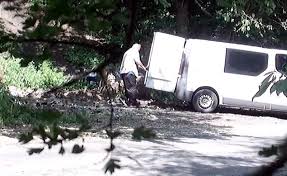
by Pigeon Patrol | Feb 26, 2020 | 4-S Gel Bird repellent, Animal Deterrent Products, Bird Deterrent Products, Bird Netting, Bird Spikes, Pigeon Control, Pigeon Droppings, Pigeon Patrol's Services, Pigeon Spikes, Pigeons in the News
Outbreak of Trichomoniasis in a wood pigeons wintering roost
An outbreak of wood pigeons (Columba palumbus) winter each year in southwestern Spain and Portugal, where they feed on acorns.
Although mortality in these wintering roosts is generally low, in winter and spring 2001 approximately 2,600 woodpigeons died from trichomoniasis.
Diagnosis of the disease was based on postmortem examination, culture and identification of the parasite, Trichomonas gallinae, by PCR. Other viral, bacterial or fungal pathogens were ruled out as cause for the die-off. The gathering of the woodpigeons at game bird feeders set up for red-legged partridges may have contributed to the outbreak.
Mortality ceased after treatment with dimetridazole via the game bird feeders. Supplementary feeding of game birds constitutes a risk factor for the appearance of disease outbreaks.
Close monitoring of infectious diseases in these populations is important, but treatment of free-living birds should be avoided in favour of other measures, as it poses risks.
Source
At Pigeon Patrol, we manufacture and offer a variety of bird deterrents, ranging from Ultra-flex Bird Spikes with UV protection, Bird Netting, 4-S Gel and the best Ultrasonic and audible sound devices on the market today.
Contact us at 1- 877– 4– NO-BIRD, (604) 585-9279 or visit our website at www.pigeonpatrol.ca
Bird Gone, Pigeon Gone, Seagull Gone, Pigeon issue, pigeon spikes, 1-877-4NO-BIRD, 4-S Gel, Bird Control, Pigeon Control, bird repellent, Bird Spikes, sonic bird repellent, stainless steel bird spikes, bird spikes Vancouver, Ultra Sonic Bird Control, Bird Netting, Plastic Bird Spikes, Canada bird spike deterrents, Pigeon Pests, B Gone Pigeon, Pigeon Patrol, pest controller, pest control operator, pest control technician, Pigeon Control Products, humane pigeon spikes, pigeon deterrents, pigeon traps, Pigeon repellents, Sound & Laser Deterrents, wildlife control, raccoon, skunk, squirrel deterrent, De-Fence Spikes, Dragons Den, Canada bird spikes, Canada pigeon, pigeon control, pigeon patrol, pigeon. Kill pigeons, crow, starling
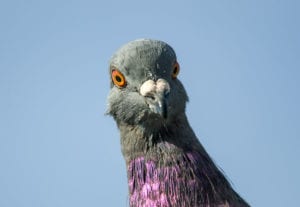
by Pigeon Patrol | Feb 26, 2020 | 4-S Gel Bird repellent, Animal Deterrent Products, Bird Spike, Pigeon Control, Pigeon Droppings, Pigeons in the News, UltraSonic Bird Control
Zombie pigeon epidemic sparks fears of transmission to humans
An “epidemic” of pigeon deaths in Moscow has sparked speculation that birds were succumbing to a virus dangerous to human beings. People who came across sick birds paying no attention to cars or passersby described them as “zombie pigeons.”
On Wednesday the Federal Veterinary and Phytosanitary Inspection Service reported that the birds’ abnormal behavior was caused by the so-called “Newcastle disease,” which can spread to humans.
Moscow’s Veterinary Committee said the mass death of pigeons in the capital was due to salmonellа poisoning, an intestinal infection spread among animals and humans. Veterinary specialists detected lesions on the gastrointestinal tracts and livers of the dead birds caused by salmonella, not Newcastle disease, Interfax reported.
Autopsies of dead birds showed that they had all suffered from a common intestinal infection that is not dangerous to humans, said Moscow’s deputy mayor for social issues, Leonid Pechatnikov. Neither the bird flu, dangerous to humans, nor fowl plague or any other diseases threatening people have been found, he said.
Gennady Onishchenko, Russia’s chief sanitary inspector, said that while the word “pigeon epidemic” was often used in the press, he doubted it could described as one. However, he warned that parents should take care if their children could come into contact with sick birds.

“We are especially worried about children’s playgrounds… And if a dead bird is found on the balcony, it must be washed with disinfectant. Doing this, one must be wearing rubber gloves,” Onishchenko said.
Although the birds’ salmonella is not harmful to humans, direct contact with the sick birds should be avoided, veterinarians said.
“The disease poses no risk for humans, provided standard precautions of personal hygiene are observed and direct contact with sick birds is avoided. Activators of avian influenza and psittacosis (an infection that can be transmitted to humans) have not been identified,” the committee said.
Salmonella infections in humans usually resolve in 5-7 days, but a small number of persons with Salmonella develop pain in their joints, irritation of the eyes and painful urination. The so-called Reiter’s syndrome can last for months or years, and can lead to chronic arthritis.
Newcastle disease, which is transmissible to humans, can cause mild conjunctivitis and influenza-like symptoms.
Ornithologists say that the so-called “epidemic” occurs every year, and not only in Moscow. “Most often, it begins in August. This is due to the fact that the breeding season is over, young birds come out with reduced immunity, and they are more susceptible to all infectious diseases,” ornithologist Natalia Anisimova told Russia’s TV Dozhd (Rain).
source
At Pigeon Patrol, we manufacture and offer a variety of bird deterrents, ranging from Ultra-flex Bird Spikes with UV protection, Bird Netting, 4-S Gel and the best Ultrasonic and audible sound devices on the market today.
Contact us at 1- 877– 4– NO-BIRD, (604) 585-9279 or visit our website at www.pigeonpatrol.ca
Bird Gone, Pigeon Gone, Seagull Gone, Pigeon issue, pigeon spikes, 1-877-4NO-BIRD, 4-S Gel, Bird Control, Pigeon Control, bird repellent, Bird Spikes, sonic bird repellent, stainless steel bird spikes, bird spikes Vancouver, Ultra Sonic Bird Control, Bird Netting, Plastic Bird Spikes, Canada bird spike deterrents, Pigeon Pests, B Gone Pigeon, Pigeon Patrol, pest controller, pest control operator, pest control technician, Pigeon Control Products, humane pigeon spikes, pigeon deterrents, pigeon traps, Pigeon repellents, Sound & Laser Deterrents, wildlife control, raccoon, skunk, squirrel deterrent, De-Fence Spikes, Dragons Den, Canada bird spikes, Canada pigeon, pigeon control, pigeon patrol, pigeon. Kill pigeons, crow, starling

by Pigeon Patrol | Feb 16, 2020 | Animal Deterrent Products, Bird Spike, Pigeon Control, Pigeon Droppings, Pigeon Spikes, UltraSonic Bird Control
Controlling Pigeon Nuisance
The common pigeon (Columba livia) that thrives throughout Missouri and most other states was developed from the European rock dove and introduced into this country as a domesticated bird. When these birds escaped captivity, they formed feral populations. Today, the pigeon is a nuisance and probably the most serious bird pest associated with human habitations.
Pigeons are commonly found around farmyards, grain elevators, feed mills, parks, city buildings, bridges and other areas that provide roosting, loafing and nesting sites. They are also a common sight around home bird feeders.
Problems caused by pigeons
Nuisance pigeon droppings on park benches, cars and buildings are not only unsightly and smelly but also corrosive, particularly to buildings. Large amounts of droppings also can kill vegetation.
Around farms, grain elevators and feed mills, pigeons consume and contaminate large quantities of grain.
Pigeons have been implicated in the transmission of diseases such as pigeon ornithosis, encephalitis and salmonella food poisoning. However, the actual incidence of transmission of diseases from pigeons to people is difficult to assess. Disease outbreaks that are directly attributed to pigeon flocks are rare.
Pigeon manure, if allowed to accumulate for several years, can harbor the causal agent of histoplasmosis, a systemic fungus disease that affects the human respiratory tract. In severe cases, histoplasmosis can be fatal. The external parasites of pigeons include various species of mites, fleas, ticks and bugs.
In addition to being a threat to human health, pigeons can be a threat to human safety, particularly around airports, where pigeon flocks have collided with aircraft, causing human fatalities.
To find out more
At Pigeon Patrol, we manufacture and offer a variety of bird deterrents, ranging from Ultra-flex Bird Spikes with UV protection, Bird Netting, 4-S Gel and the best Ultrasonic and audible sound

devices on the market today.
Contact us at 1- 877– 4– NO-BIRD, (604) 585-9279 or visit our website at www.pigeonpatrol.ca
Bird Gone, Pigeon Gone, Seagull Gone, Pigeon issue, pigeon spikes, 1-877-4NO-BIRD, 4-S Gel, Bird Control, Pigeon Control, bird repellent, Bird Spikes, sonic bird repellent, stainless steel bird spikes, bird spikes Vancouver, Ultra Sonic Bird Control, Bird Netting, Plastic Bird Spikes, Canada bird spike deterrents, Pigeon Pests, B Gone Pigeon, Pigeon Patrol, pest controller, pest control operator, pest control technician, Pigeon Control Products, humane pigeon spikes, pigeon deterrents, pigeon traps, Pigeon repellents, Sound & Laser Deterrents, wildlife control, raccoon, skunk, squirrel deterrent, De-Fence Spikes, Dragons Den, Canada bird spikes, Canada pigeon, pigeon control, pigeon patrol, pigeon. Kill pigeons, crow, starling

by Pigeon Patrol | Feb 16, 2020 | Animal Deterrent Products, Bird Deterrent Products, Bird Netting, Bird Spike, Pigeon Control, Pigeon Droppings, Pigeon Patrol's Services, Pigeon Spikes
Pigeon allergy: A pigeon allergy is an adverse reaction by the body’s immune system to pigeons. The allergy is usually associated with the skin, feathers or excrement of the pigeon. The body’s immune system produces immunoglobulin E (IgE – an antibody) and histamine in response to contact with the allergen. The specific symptoms that can result can vary considerably amongst patients e.g. skin and respiratory symptoms
- Avoid contact with the allergen, antihistamines, bronchodilators for asthmatic symptoms
- Animal allergy is best treated by prevention of exposure to sensitising agents. Where this is not possible, treatment of allergy is dependant upon the type of allergic symptom, the body system affected, and the severity of the reaction
To find out more please visit here
At Pigeon Patrol, we manufacture and offer a variety of bird deterrents, ranging from Ultra-flex Bird Spikes with UV protection, Bird Netting, 4-S Gel and the best Ultrasonic and audible sound devices on the market today.
Contact us at 1- 877– 4– NO-BIRD, (604) 585-9279 or visit our website at www.pigeonpatrol.ca
Bird Gone, Pigeon Gone, Seagull Gone, Pigeon issue, pigeon spikes, 1-877-4NO-BIRD, 4-S Gel, Bird Control, Pigeon Control, bird repellent, Bird Spikes, sonic bird repellent, stainless steel bird spikes, bird spikes Vancouver, Ultra Sonic Bird Control, Bird Netting, Plastic Bird Spikes, Canada bird spike deterrents, Pigeon Pests, B Gone Pigeon, Pigeon Patrol, pest controller, pest control operator, pest control technician, Pigeon Control Products, humane pigeon spikes, pigeon deterrents, pigeon traps, Pigeon repellents, Sound & Laser Deterrents, wildlife control, raccoon, skunk, squirrel deterrent, De-Fence Spikes, Dragons Den, Canada bird spikes, Canada pigeon, pigeon control, pigeon patrol, pigeon. Kill pigeons, crow, starling
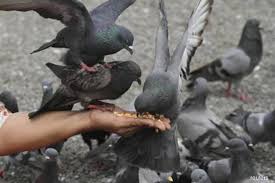
by Pigeon Patrol | Feb 16, 2020 | Bird Deterrent Products, Bird Netting, Bird Spike, Pigeon Control, Pigeon Patrol's Services, Pigeon Spikes, Pigeons in the News
The dossier spills over into two drawers of files full of hand-scribbled notes, maps marked with sharp black dots – and snapshots of a shadowy lady figure, scattering pigeon seed.
This is Laura Dodson’s nemesis.
There was a time when Dodson went after the crack dealers in her Hollywood neighborhood with such a vengeance that city officials honored her with a plaque. Now, she has declared war on another urban scourge. For three years, she has enlisted snitches, set up overnight stakeouts, appealed for help from city leaders and the police.
Her quarry? Pigeon lady Susie Kourinian, the furtive form in the photos.
Kourinian is no ordinary bird lover. She earns her seed money as a seamstress to the stars; she appeared in InStyle magazine tweaking Cate Blanchett’s hem and is said to keep actresses such as Megan Mullally in finery.
That glittery occupation gives Kourinian the wherewithal to make a lot of pigeons happy. Kourinian once told police she spends $65,000 a year on bird feed – enough to dump 500 pounds of birdseed every day, a lifeline for the more than 5,000 pigeons who now populate the two square miles of this neighborhood northwest of downtown Los Angeles.
Kourinian is reputedly so crafty that within moments, she can pop the trunk of her black sport utility vehicle, scatter 75 pounds of pigeon feed and disappear into the night.
She has been doing this for a decade, police say, but neither they nor Dodson’s small band of pigeon patrollers – dubbed “Citizen Pigeon” – have been able to stop her.
“When you realize how many hours and manpower it takes to catch the pigeon lady … ,” Dodson said. “She’s got the perfect crime because who else would have the resources to do this?”
Across the nation, a virtual war on pigeons has been waged in many ways: poisonings, electric wires, robotic falcons and even bird relocations to pigeon farms. In some places the mere mention of feeding bans has raised the ire of legions of pigeon fanciers who ridicule efforts to levy fines for tossing birds a handful of bread crumbs.
But pigeons will reproduce based on the amount of food available. In Hollywood, they have.
Stephanie Boyles, a wildlife biologist with the Humane Society who has developed pigeon control programs around the country, said she’s never seen anything like it. To get a sense of how bad the problem was, she once scattered some bread in a Hollywood parking lot.
Within moments, the bread was gone and thousands of eyes were upon her. An eerie cooing suggested they wanted more.
“I’ve traveled in Europe, I’ve been to New York City many, many times, Washington D.C. and Chicago … places that claim to have pigeon problems. They do, but compared to Hollywood, it’s not even a fair comparison,” Boyles said.
Critics maintain that pigeons do millions of dollars in damage a year nationwide. Their guano is caustic, and has been blamed for all sorts of problems, from poor water quality in Pismo Beach to the collapse of the Minneapolis bridge.
In Hollywood, critics say, the pigeons conflict with a beautification program aimed at reviving the famed neighborhood, for years blighted by dingy sex shops along the Hollywood Walk of Fame. When officials took down the marquee of Grauman’s Chinese Theatre to refurbish the building, pigeon guano had completely corroded the metal.
Legions of pigeons sit waiting for food on rooftops, under freeways and telephone lines, prompting business owners to put up canopies and umbrellas to protect customers.
“If I were to feed 5,000 cats a day, you know how many cats we’d see a year from now?” said Thaddeus Smith, who once used a jackhammer to get guano off the roof of his Music Box nightclub. “When we walk to lunch we see bird seed everywhere and thousands of pigeons sitting on wires saying `hmmm.”‘
At Pigeon Patrol, we manufacture and offer a variety of bird deterrents, ranging from Ultra-flex Bird Spikes with UV protection, Bird Netting, 4-S Gel and the best Ultrasonic and audible sound devices on the market today.
souce
Contact us at 1- 877– 4– NO-BIRD, (604) 585-9279 or visit our website at www.pigeonpatrol.ca
Bird Gone, Pigeon Gone, Seagull Gone, Pigeon issue, pigeon spikes, 1-877-4NO-BIRD, 4-S Gel, Bird Control, Pigeon Control, bird repellent, Bird Spikes, sonic bird repellent, stainless steel bird spikes, bird spikes Vancouver, Ultra Sonic Bird Control, Bird Netting, Plastic Bird Spikes, Canada bird spike deterrents, Pigeon Pests, B Gone Pigeon, Pigeon Patrol, pest controller, pest control operator, pest control technician, Pigeon Control Products, humane pigeon spikes, pigeon deterrents, pigeon traps, Pigeon repellents, Sound & Laser Deterrents, wildlife control, raccoon, skunk, squirrel deterrent, De-Fence Spikes, Dragons Den, Canada bird spikes, Canada pigeon, pigeon control, pigeon patrol, pigeon. Kill pigeons, crow, starling
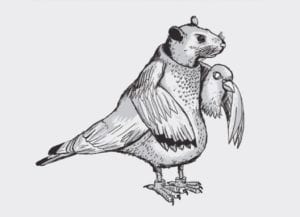
by Pigeon Patrol | Feb 16, 2020 | Bird Netting, Pigeon Control, Pigeon Droppings, Pigeon Patrol's Services, Pigeon Spikes, Pigeons in the News
Rat with wings in Dubai: Pigeons have become a nuisance in the city, leaving many residents exasperated.
These birds which have been breeding uncontrollably are messing up property with their droppings.
Building owners are having to hire pest-control firms to ward off these fast-breeding birds, they are like rat with wings.
Dr Elmahi El Tilib Gubran, pest control studies officer at Dubai Municipality’s Public Health Department, while describing pigeons as a “serious” problem, said it’s hard to put a figure to their numbers in Dubai, where it is illegal to cull pigeons.
Serious problems
“They cause serious problems on structures and are a real nuisance to get rid of,” said Dr Gubran, who added that the municipality traps them and gives them to a falcon hospital as feed.
With a plentiful supply of food, water and nesting perches, the city’s pigeon population has exploded in recent years. The problem prevails across the emirate, right from the residential districts of Karama, Bur Dubai and Deira, to the five-star hotels and industrial buildings in Jebel Ali and Jumeirah.
To deal with the problem, pest-control films have introduced a number of measures – from installing anti-roosting spikes on building tops, to the use of PVC (poly-vinyl chloride) netting and flying falcons to scare them away.
Pigeon droppings have been known to carry disease causing germs (see box on left). The droppings are acidic and can eat away at tar-based roofing, damage machinery, air conditioning systems and car paint work.
XPRESS went out with a team from Trap Pest Control, which uses nets and spikes for clients in the industrial areas of Jebel Ali as well as palaces.
Amin Jarrar, who runs the company, said: “We get calls from companies all the time asking to use our service. We don’t kill the pigeons because that is illegal, so all we do is move them on.”
One reason pigeons are widespread in places like Deira, Bur Dubai and Karama is that landlords are unwilling to invest in preventive measures, he said. “In Dubai, many tenants as well as property owners are coming and going all the time, so to invest in something like this is not appealing for them.”
Netting costs Dh75 per square metre and a metre of spikes costs Dh75. With spikes, the protruding pins make it impossible for pigeons to land, encouraging them to go elsewhere without them getting hurt.
Other pest-control companies treat problem areas with anti-pigeon spray that wards off the birds without harming them or other animals for up to a year after treatment.
While fake hawks and falcons are used in some UK cities to scare off pigeons, a Dubai company is using real falcons to do the job.
Al Hurr Falconry, based in Nad Al Sheba, uses 21 peregrine falcons – of which 14 constantly patrol the air in places like Jumeirah, while seven are used for breeding.
Battle in the air
David Stead, managing director of Al Hurr, describes the “battle” with pigeons as a “war of attrition”. Since his company was set up seven years ago, business has never been busier. “We get calls from people running five-star hotels to deal with pigeon droppings on their property,” said Stead.
“Pigeons are also one of the fastest birds in the air, and one of the few birds of prey that can catch them are falcons,” he said. “When pigeons see falcons, they go ballistic and scatter all over the place as they think they are going to be eaten. I’ve seen them almost fall to the ground in a desperate attempt to pick up speed and escape.”
Peregrine falcons can catch birds in the air and urban peregrines eat a lot of pigeons. Stead’s peregrine falcons, however, are trained to hover in the air for around a few minutes before returning to their handlers.
For their work to have a lasting effect, Stead and his team maintain a presence at the client’s buildings up to five days a week.
“It’s not a case of flying once and then leaving it,” he explained. “You have got to maintain an almost permanent presence around the building. You’ve got to make the pigeons think that the falcon lives in the area. That is the only way to get them to go away. ”
“Other countries have tried things like shooting the pigeons with air guns, but they alway return,” said Stead.
Methods to deal with them
- Draping a PVC net across overhanging areas to prevent the birds from flying to a specific location.
- Installing spikes on ledges or positions of walls and buildings to prevent pigeons from having a comfortable spot to rest on.
- Setting up brown coloured balls on a piece of string to fool the pigeons into thinking it is a falcon. (no photo)
How other nations dealt with the issue:
Switzerland:
Had experimented with a pigeon contraceptive pill, but it was found to be ineffective in trials
and often was also eaten by fertile birds from other species, making it difficult to specifically target pigeons.
United Kingdom:
Although pigeons are tolerated at Trafalgar Square, in London, as a tourist attraction elsewhere companies have hired snipers to shoot the birds off buildings with airguns. Specially licensed pest controllers can also use narcotic-laced drugs to “knock out” the birds before the pigeon’s necks are dislocated.
United States:
Use of plastic models of birds of prey is popular but the effect of scaring off pigeons has been found to work only for a short period of time.
Birds of a feather
- Pigeons are scared of peregrine falcons, who primarily eat birds they catch in the air.
- Between the 16th and 18th centuries pigeon droppings were a highly prized fertiliser and considered far more potent than farmyard manure – so guards had to be stationed near pigeon houses to stop thieves from stealing it. In 16th century England, it was the only known source of saltpetre, an ingredient of gunpowder. In Iran pigeon houses were set up and used simply as a source of fertiliser for melon crops and in France and Italy it was used to fertilise vineyards and hemp crops.
- Pigeons are gregarious and tend to be found in flocks of around twenty to thirty birds. Seeds and grains make up their diet.
- A pigeon nest is usually constructed with small twigs and located on covered building ledges, well-hidden from view. The male brings the nesting material to his mate, one piece at a time.
- Pigeons reproduce throughout the year and can raise four or five broods annually.
- Pigeons can hear sounds at much lower frequencies than humans, such as distant thunderstorms and even far-away volcanoes, which may explain why pigeons sometimes fly away for no apparent reason.
- Pigeons can fly up to 40 or 50 miles per hour and may travel as far as 600 miles a day. They can detect the Earth’s magnetic fields, which, along with the ability to tell direction by sun, seems to help them find their way home.
Source
At Pigeon Patrol, we manufacture and offer a variety of bird deterrents, ranging from Ultra-flex Bird Spikes with UV protection, Bird Netting, 4-S Gel and the best Ultrasonic and audible sound devices on the market today.
Contact us at 1- 877– 4– NO-BIRD, (604) 585-9279 or visit our website at www.pigeonpatrol.ca
Bird Gone, Pigeon Gone, Seagull Gone, Pigeon issue, pigeon spikes, 1-877-4NO-BIRD, 4-S Gel, Bird Control, Pigeon Control, bird repellent, Bird Spikes, sonic bird repellent, stainless steel bird spikes, bird spikes Vancouver, Ultra Sonic Bird Control, Bird Netting, Plastic Bird Spikes, Canada bird spike deterrents, Pigeon Pests, B Gone Pigeon, Pigeon Patrol, pest controller, pest control operator, pest control technician, Pigeon Control Products, humane pigeon spikes, pigeon deterrents, pigeon traps, Pigeon repellents, Sound & Laser Deterrents, wildlife control, raccoon, skunk, squirrel deterrent, De-Fence Spikes, Dragons Den, Canada bird spikes, Canada pigeon, pigeon control, pigeon patrol, pigeon. Kill pigeons, crow, starling
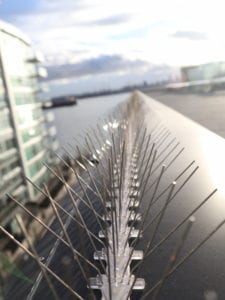
by Pigeon Patrol | Feb 16, 2020 | Bird Deterrent Products, Bird Netting, Bird Spikes, Pigeon Control, Pigeon Droppings, Pigeon Patrol's Services, Pigeon Spikes, UltraSonic Bird Control
How to get rid of pigeons?
How to get rid of pigeons? The Council has no policy to control or cull birds within the area.
It is generally acknowledged that reducing the population by culling can only have a short-term effect, and populations soon recover.
Food is the most important factor determining the size of any pigeon population, and the best known, long-term solution to pigeon problems is to restrict its availability.
Numbers can also be reduced by restricting roosting and nesting spaces. Replacing broken roof tiles and closing open/broken windows will stop pigeons gaining access to buildings. Specialist contractors use fine mist nets and small spikes placed on windows to discourage pigeons from roosting on buildings.
Specialist contractors can be employed to carry out appropriate action. Darlington Borough Council does not provide this service or any financial assistance to carry out the work.
What the law says about pigeons
Most birds and their nests are protected under the Wildlife and Countryside Act 1981.
The Act allows for the control of certain birds, including feral pigeons, by authorised persons using specified methods to prevent serious damage to agriculture, to preserve public health / air safety, or to conserve other wild birds.
The use of spring traps, poisons, certain types of nets, gassing and sticky substances that may entangle a bird are illegal. Approved methods include trapping or drugging followed by humane destruction and shooting.
It is an offence under the Criminal Damage Act 1971 to intentionally kill a racing pigeon.
Source

At Pigeon Patrol, we manufacture and offer a variety of bird deterrents, ranging from Ultra-flex Bird Spikes with UV protection, Bird Netting, 4-S Gel and the best Ultrasonic and audible sound devices on the market today to get rid of pigeons.
Contact us at 1- 877– 4– NO-BIRD, (604) 585-9279 or visit our website at www.pigeonpatrol.ca
Bird Gone, Pigeon Gone, Seagull Gone, Pigeon issue, pigeon spikes, 1-877-4NO-BIRD, 4-S Gel, Bird Control, Pigeon Control, bird repellent, Bird Spikes, sonic bird repellent, stainless steel bird spikes, bird spikes Vancouver, Ultra Sonic Bird Control, Bird Netting, Plastic Bird Spikes, Canada bird spike deterrents, Pigeon Pests, B Gone Pigeon, Pigeon Patrol, pest controller, pest control operator, pest control technician, Pigeon Control Products, humane pigeon spikes, pigeon deterrents, pigeon traps, Pigeon repellents, Sound & Laser Deterrents, wildlife control, raccoon, skunk, squirrel deterrent, De-Fence Spikes, Dragons Den, Canada bird spikes, Canada pigeon, pigeon control, pigeon patrol, pigeon. Kill pigeons, crow, starling

by Pigeon Patrol | Feb 16, 2020 | Bird Deterrent Products, Bird Netting, Bird Spikes, Pigeon Control, Pigeon Droppings, Pigeon Spikes, UltraSonic Bird Control
Do pigeons do any harm? – pigeons dropping are not only unsightly but are acidic and in large quantities can cause damage to buildings and machinery. Nesting material, droppings and feathers can also block gutters and air vents.
Public health – pigeons can carry diseases, some of which may do harm to people, for example if droppings contaminate food stuffs. As such their presence cannot be tolerated in and around food premises. They also carry mites which can cause skin disease and dust from their feathers can cause respiratory problems in confined spaces.
Accidents – pigeon droppings and food left down for pigeons can cause walkways and fire escapes on buildings to become slippery and dangerous. Startled flocks can take flight suddenly, causing hazards to motorists and pedestrians.
Other birds – large numbers of pigeons can force smaller birds away from feeding areas. The pigeons also spread disease to other birds, reducing their numbers.
Source
At Pigeon Patrol, we manufacture and offer a variety of bird deterrents, ranging from Ultra-flex Bird Spikes with UV protection, Bird Netting, 4-S Gel and the best Ultrasonic and audible sound devices on the market today.
Contact us at 1- 877– 4– NO-BIRD, (604) 585-9279 or visit our website at www.pigeonpatrol.ca
Bird Gone, Pigeon Gone, Seagull Gone, Pigeon issue, pigeon spikes, 1-877-4NO-BIRD, 4-S Gel, Bird Control, Pigeon Control, bird repellent, Bird Spikes, sonic bird repellent, stainless steel bird spikes, bird spikes Vancouver, Ultra Sonic Bird Control, Bird Netting, Plastic Bird Spikes, Canada bird spike deterrents, Pigeon Pests, B Gone Pigeon, Pigeon Patrol, pest controller, pest control operator, pest control technician, Pigeon Control Products, humane pigeon spikes, pigeon deterrents, pigeon traps, Pigeon repellents, Sound & Laser Deterrents, wildlife control, raccoon, skunk, squirrel deterrent, De-Fence Spikes, Dragons Den, Canada bird spikes, Canada pigeon, pigeon control, pigeon patrol, pigeon. Kill pigeons, crow, starling



















